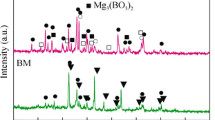Abstract
The effect of several parameters on the recovery of silicon dioxide from calcined boron mud (CBM) such as stirring speed, temperature, sodium silicate concentration, and carbonation time was studied. The recovery of silicon dioxide is 88 % when the stirring speed is 450 r·min−1, temperature is 60 °C, sodium silicate concentration is 1 mol·L−1, and the carbonation time is 6 h. The effect of carbonation time on the recovery of silicon dioxide is divided into three kinetic regimes, and the carbonation process of sodium silicate solution follows a second-order reaction based on the double-film theory model. The apparent rate constant of the three kinetic regimes is 0.064, 3.178, and 1.130 L·h·mol−1, respectively. The amorphous SiO2 products obtained by carbonating the purified solution have 99.6 % purity and are spherical with diameters of about 100 nm.











Similar content being viewed by others
References
Yin YX, Zhang YH, Zhen ZC, Chu PK, Lv FZ, Ji JH. Thermal degradation and flame retarding characteristics of polypropylene composites incorporated with boron mud. Compos Sci Technol. 2013;85(8):131.
Ma X, Ma HW, Jiang QQ, Jiang ZQ. Preparation of magnesium hydroxide nanoflowers from boron mud via anti-drop precipitation method. Mater Res Bull. 2014;56(8):113.
Yang LL, Wang HM, Zhu X, Li GR. Effect of boron mud and CaF2 on surface tension and density of CaO–SiO2–B2O3 ternary slag systems. J Iron Steel Res Int. 2014;21(8):745.
Wang RX, Zeng B, Yu P, Wang ZQ, Ruan JG, Xie BY. Roasting pretreatment of poly-metallic and complex gold concentrate to extract gold, silver and copper. Chin J Rare Met. 2014;38(1):86.
Yuan SQ, Dong J, Wang C, Wang ZJ. Comprehensive treating copper tailing and nickel residue. Chin J Rare Met. 2014;38(1):108.
Ning ZQ, Zhai YC, Zhou D, Cao YX, Gu HM. Study of the technique for the preparation of epsomsalt from the boron mud. Light Met. 2007;(7):61.
Li YT. Study on industrialization of producing light magnesium carbonate from boron mud. Liaoning Chem Ind. 2001;30(7):307.
Yu JC, Xu AW, Zhang LZ, Song RQ, Wu L. Synthesis and characterization of porous magnesium hydroxide and oxide nanoplates. J Phys Chem B. 2004;108(1):64.
Wei ZQ, Qi H, Ma PH, Bao JQ. A new route to prepare magnesium oxide whisker. Inorg Chem Commun. 2002;5(2):147.
Zhong WN, Liu DC. Application of environment friendly flame retardants made of gray aluminum and boron mud in styrene butadiene rubber. J Shenyang Univ Chem Technol. 2012;26(2):137.
Liu GJ, Ouyang C, Ran WX, Zhang QQ, Xin CY. Synthetic recovery of spent Co–Mo catalyst by NaOH-leaching. Chin J Rare Met. 2014;38(2):270.
Mu WN, Zhai YC. Desiliconization kinetics of nickeliferous laterite ores in molten sodium hydroxide system. Trans Nonferrous Met Soc. 2010;20(2):330.
Xia YX, Meng LY, Jiang YJ, Zhang YS, Dai XX, Zhai MJ. Facile preparation of MnO2 functionalized baker’s yeast composites and their adsorption mechanism for cadmium. Chem Eng J. 2015;259(1):927.
Mu WN, Zhai YC, Liu Y, Xu Q. A green process for recovering nickel from nickeliferous laterite ores. Trans Nonferrous Met Soc. 2010;20(s1):65.
Zhu GC, Zhang HJ, Zhao YN. A novel recirculating reactor for the leaching of magnesia by CO2. Hydrometallurgy. 2008;92(3–4):141.
Xu Y. Chemical Reaction Kinetics. VII Multiphase Reaction Kinetics. In: Yang Q, Ding JH, editors. Beijing: Chemical Industry Press; 2005. 125.
Adrover A, Nobili M. Release kinetics from oral thin films: theory and experiments. Chem Eng Res Des. 2015;98(6):188.
Fan JJ, Li ZZ, Zhou WY, Miao YC, Zhang YJ, Hu JH, Shao GS. Dye-sensitized solar cells based on TiO2 nanoparticles/nanobelts double-layered film with improved photovoltaic performance. Appl Surf Sci. 2014;319(11):75.
Acknowledgments
This work was financially supported by the National Natural Science Foundation of China (No. 51204037) and the Fundamental Research Funds for the Central Universities, China (No. N140204016).
Author information
Authors and Affiliations
Corresponding author
Rights and permissions
About this article
Cite this article
Ning, ZQ., Zhai, YC., Xie, HW. et al. Recovery of silica from sodium silicate solution of calcined boron mud. Rare Met. 35, 204–210 (2016). https://doi.org/10.1007/s12598-015-0654-7
Received:
Revised:
Accepted:
Published:
Issue Date:
DOI: https://doi.org/10.1007/s12598-015-0654-7



